
|
xTuple ERP Reference Guide |
Contacts are people who may be associated directly with CRM accounts, customers, ship-to addresses, vendors, vendor addresses, and sites. To create a new contact, go to . The following screen will appear:

When creating a new contact, you are presented with the following options:
Displays the system-defined number used to identify the contact.
Select if you are actively doing business with this contact. Not selecting makes the contact inactive.
Enter the following details for the contact's name:
Select a title from the list of available titles.
Enter the contact's first name.
Enter the contact's last name.
Enter the contact's initials.
Enter the contact's company name.
Enter the contact's job title.
Enter the contact's e-mail address. If the contact has more than one email address, you can enter them by clicking on the arrow and selecting the Edit List option. This will bring up the Contact Email Addresses screen, as shown in the following screenshot:
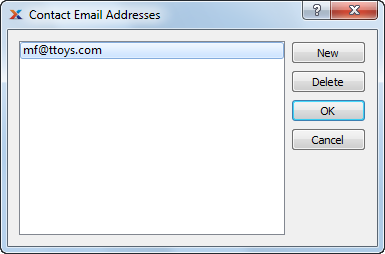
If you use the Contact Merge utility to merge duplicate contact records, multiple email addresses can be preserved and displayed on the Contact Email Addresses list. To learn more about the Contact Merge utility, please see Section 10.4, “ Merge Contacts”.
Select to have the contact's email address added to any marketing campaigns you run. If not selected, the contact will not be included in the campaigns.
Enter the contact's website address.
Enter the contact's phone number. You can add as many fields as needed. Select a category from the drop-down list.
Enter the contact's office number.
Enter the contact's home number.
Enter the contact's cell phone number.
Enter the contact's fax number.
Enter an alternate phone number for the contact.
Specify the user who is the owner of the contact (if any).
Manually enter address information in the fields below—or use the lookup feature to select pre-existing address information. If a new address is manually entered here, that address will be added automatically to the master list of addresses. For additional documentation related to creating addresses, see Section 8.1, “ New Address”.
If a new address is manually entered here, that address will be added automatically to the master list of addresses.
To see how the contact is associated with other records, select the tab at the bottom of the Contact screen. This list displays information on all contact cross-references, including used-at reference, CRM account number, CRM account name, role, and active status. Relationships can be added to this list from their respective areas. These relationships can be opened and edited from this list.
To add comments to a contact, select the tab at the bottom of the Contact screen. The following screen will appear:
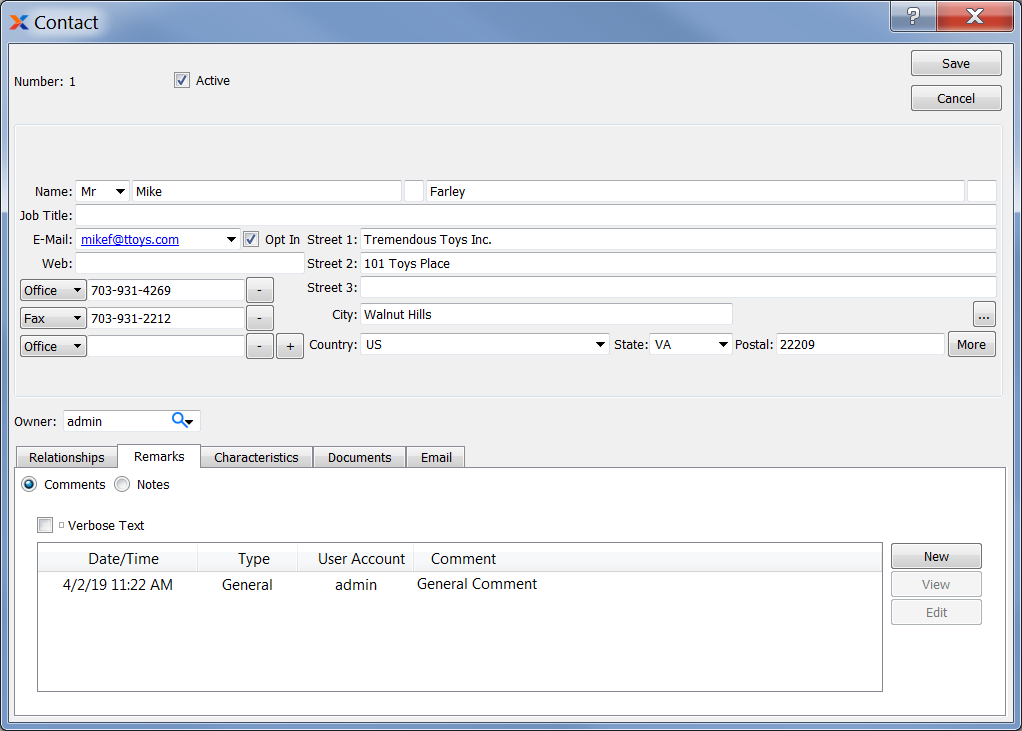
When adding or reviewing comments, you are presented with the following options:
Select to display all comments in the list in an expanded view which includes the entire text of each comment. To edit a comment, simply select the link next to the comment. That link will not be shown for changelog comments, which can't be edited. If the Verbose Text option is not selected, the comment list will display only header level information for each comment.
Display lists comments related to the record.
The following buttons are available:
Opens screen for creating a new comment.
Highlight a comment and then select this button to reach a read-only view of the Edit screen.
Enables you to edit highlighted comments—as long as the comments are not changelog comments. ChangeLog comments are system-generated and may not be edited. The Edit screen is the same as that for creating a new comment—except that when editing, the fields will contain comment information. Double-clicking on a comment will also bring you to the editing screen.
To enter a new comment, select the button. The following screen will appear:

Select a comment type from the drop-down list to classify the comment. This is a required step. Comment types may be system-defined (i.e., changelog and general) or user-defined, as described in Section 13.2.3, “Comment Types”. Once you have specified a comment type, begin typing your comment in the main text area. The text area features word-wrapping and scroll-bar support for longer comments.
The following buttons are unique to this screen:
Select to show the complete list (i.e., thread) of comments associated with the record. To hide the list, simply select the button again. The comment thread will show the most recent comment first.
Contact characteristics are user-defined definitions of a contact which may be used to provide additional layers of description. To enter characteristics associated with a contact, select the tab. The following screen will appear:
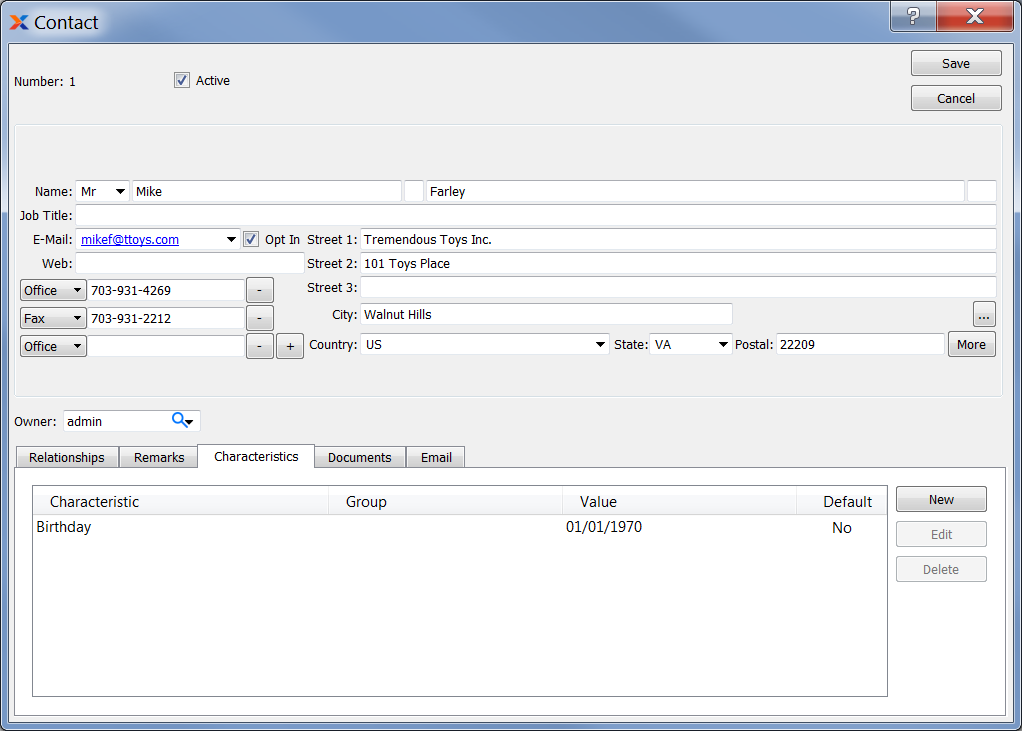
Use contact characteristics, for example, to record and remember a contact's birthday—or similar personal information.
To create a new characteristic for your current context, select the button from the characteristics list. The following screen will appear:
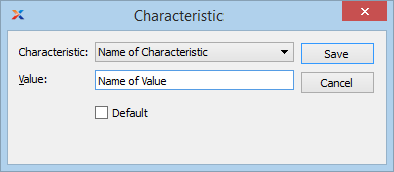
When creating a new characteristic, you are presented with the following options:
Select a characteristic from the list of characteristics available for your current context. To learn more about how characteristics are linked to specific contexts, please see Section 9.2.2.1, “Characteristic”.
Enter a value to associate with the characteristic.
In some contexts, the Default option will appear. Select if the value entered is the default value for the specified characteristic. Default values will always be listed first where characteristics are used.
To view the documents associated with a contact, select the tab. The following screen will appear:
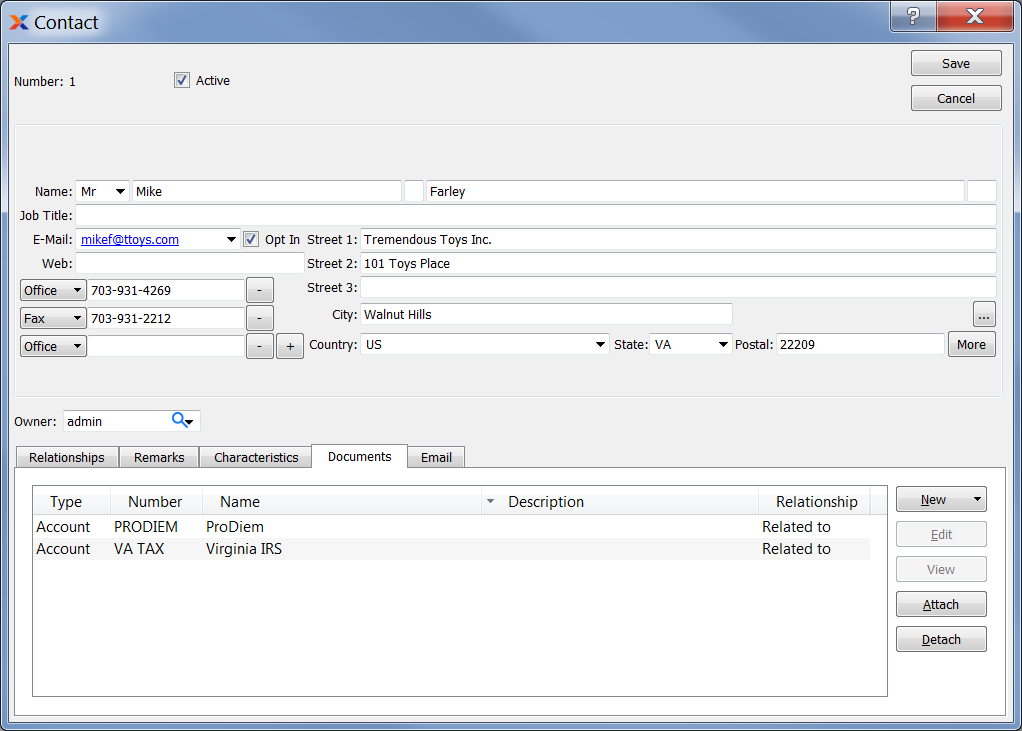
Contact Documents
When associating documents, you are presented with the following options:
Select to create a new document and associate it with the current record. You may create the following document types:
Select to create a new image association.
Select to create a new fixed asset association.
Select to create a new maintenance order association.
Select to create a new incident and associate it.
Select to create a new project and associate it.
Select to create a new opportunity and associate it.
Select to create a new task and associate it.
Enables you to edit associated documents. The Edit screen is the same as that for creating a new document—except that when editing, the fields will contain document information. Double-clicking on a document will also bring you to the editing screen.
Highlight a document and then select this button to reach a read-only view of the Edit screen.
Select to associate already-existing documents. The following document types may be attached: contact, account, customer, employee, file, image, incident, item, opportunity, project, purchase order, sales order, vendor, web site, work order.
Highlight a document and then select this button to remove the association.
To associate already-existing documents, select the button. The following screen will appear:
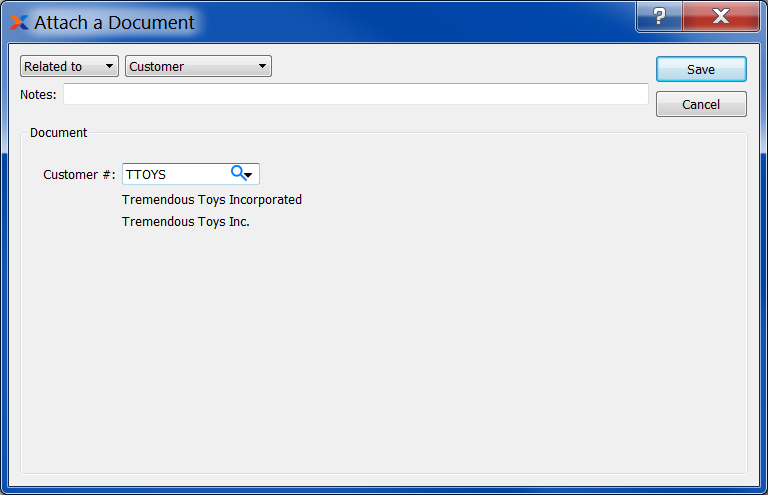
When associating already-existing documents, you are presented with the following options:
Indicate how the document is related to the current record. The following relationship options are available: related to, parent of, child of, duplicate of.
Specify the kind of document you want to associate. The following document types may be attached: contact, account, customer, employee, file, image, incident, item, opportunity, project, purchase order, sales order, vendor, web site, work order. When associating files, you will also be given the option to save the file to the database.
There is no file size restriction when saving files to the database. However, excessively large files could cause storage and performance issues.
Leave any notes on the document file as needed.
Use the lookup tool to identify the specific document you want to attach. The data entry options will vary depending on the document type you select.
To view email associated with a contact, select the tab. The following screen will appear:
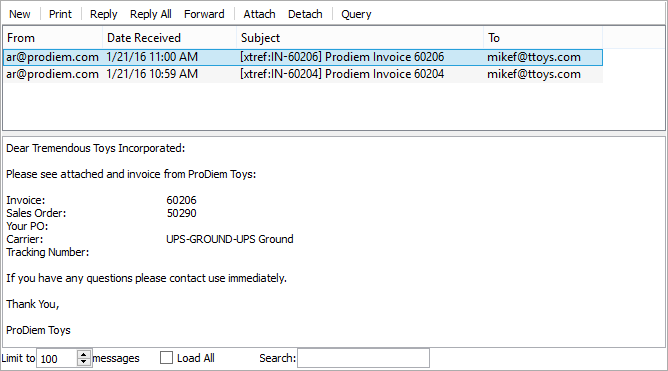
When viewing associated emails, you are presented with the following options:
Display lists associated emails.
The content of a highlighted email will be displayed here.
Specify the maximum number of associated emails you want to be displayed in the email list. If the list is extremely long, you may experience some slowness when opening the screen.
Select to load all associated emails into the list.
Enter a string of letters or complete words to search for matches in the list of associated emails. The search will scan through subject lines, To addresses, and From addresses.
The following buttons are unique to this screen:
Select to send a new email, using the default email program on your computer.
Highlight an email and then select this button to print a copy of the email.
Highlight an email and then select this button to reply to the email's sender, using the default email program on your computer.
Highlight an email and then select this button to reply to everyone associated with the email, using the default email program on your computer.
Highlight an email and then select this button to forward the email to another person(s), using the default email program on your computer.
Highlight an email and then select this button to attach an email associated with a contact in your contact list.
Highlight an email and then select this button to remove the associated email from the list.